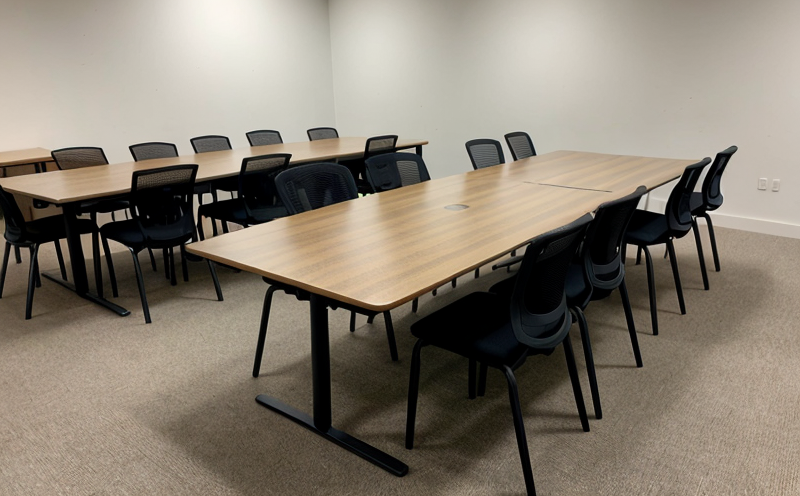ANSI HFES 100 Human Factors Ergonomic Testing for Computer Desks
The ANSI/HFES 100 standard is a comprehensive guideline that ensures the design of computer desks meets ergonomic standards and user requirements. This service focuses on testing the ergonomics, comfort, and usability of desk surfaces aimed at enhancing human comfort during extended periods of work or study. The primary aim is to prevent musculoskeletal disorders (MSDs) by ensuring that the desk's height, slope, and other factors are optimized for individual users.
The ANSI/HFES 100 standard specifically addresses the design of desks with computer use in mind. It covers a range of aspects including but not limited to:
- Work surface dimensions
- Under-desk clearance
- Chair compatibility
- Aesthetic considerations for workspaces
The testing process involves a series of steps that ensure the desk meets ergonomic standards. The first step is to identify the target population and their specific needs, which guides the design parameters. Once the parameters are set, prototypes of the desks are created and tested in various scenarios.
Testing typically includes:
- Evaluation of surface height
- Determination of under-desk clearance
- Assessment of chair compatibility
- Review of aesthetic design
The testing process is rigorous and involves a series of metrics to ensure the desk's ergonomic compliance. The use of real-world data from multiple users helps in fine-tuning the designs for comfort and usability.
Once the prototypes are tested, they undergo detailed analysis using various tools such as anthropometric measurements, biomechanical strain evaluation, and user feedback surveys. These analyses provide insights into how well the desk meets ergonomic requirements and user expectations.
The ANSI/HFES 100 standard is widely recognized for its strict compliance guidelines. It ensures that desks are not only aesthetically pleasing but also functional in terms of ergonomics. This service helps manufacturers ensure their products meet international standards, thereby enhancing customer satisfaction and reducing the risk of complaints or returns.
The testing process is crucial as it ensures that the desk's design meets ergonomic requirements, thus preventing musculoskeletal disorders (MSDs) among users. By adhering to this standard, manufacturers can introduce innovative designs that cater to user needs, ensuring a comfortable working environment.
| Standard | Description |
|---|---|
| ANSI/HFES 100-2007 | Guidelines for Human Factors Engineering of Computer Workstations |
| ISO 9241-302 | Ergonomics of human-system interaction – Part 302: Office workstations with computer terminals |
| Standard | Description |
|---|---|
| EN ISO 9241-302 | Ergonomics of human-system interaction – Part 302: Office workstations with computer terminals |
| IEC 62474 | Human factors design process for electrical and electronic systems, including software |
Applied Standards
The ANSI/HFES 100 standard is supported by several international standards that ensure the ergonomic design of computer desks. These include:
| Standard | Description |
|---|---|
| ANSI/HFES 100-2007 | Guidelines for Human Factors Engineering of Computer Workstations |
| ISO 9241-302 | Ergonomics of human-system interaction – Part 302: Office workstations with computer terminals |
| EN ISO 9241-302 | Ergonomics of human-system interaction – Part 302: Office workstations with computer terminals |
| IEC 62474 | Human factors design process for electrical and electronic systems, including software |
Why Choose This Test
The ANSI HFES 100 Human Factors Ergonomic Testing ensures that computer desks are designed with user comfort and safety in mind. By adhering to this standard, manufacturers can ensure their products meet international standards, which enhances customer satisfaction and reduces the risk of complaints or returns.
Choosing this test offers several benefits:
- Ensures compliance with international standards
- Reduces the risk of musculoskeletal disorders (MSDs)
- Improves user comfort and satisfaction
- Enhances product marketability
The testing process is rigorous and involves a series of metrics to ensure the desk's ergonomic compliance. The use of real-world data from multiple users helps in fine-tuning the designs for comfort and usability.
By adhering to this standard, manufacturers can introduce innovative designs that cater to user needs, ensuring a comfortable working environment. This not only enhances customer satisfaction but also reduces the risk of complaints or returns, thereby improving brand reputation.
Quality and Reliability Assurance
The quality and reliability assurance process for ANSI HFES 100 Human Factors Ergonomic Testing involves a series of steps to ensure the desk's design meets ergonomic requirements. This includes:
- Evaluation of surface height
- Determination of under-desk clearance
- Assessment of chair compatibility
- Review of aesthetic design
The testing process is rigorous and involves a series of metrics to ensure the desk's ergonomic compliance. The use of real-world data from multiple users helps in fine-tuning the designs for comfort and usability.
The quality assurance team works closely with the R&D engineers and compliance officers to ensure that all aspects of the desk are optimized for user comfort and safety. This includes:
- Conducting regular audits
- Performing field tests
- Reviewing user feedback
- Implementing continuous improvement processes
The quality assurance process is an ongoing effort to ensure that the desk's design meets ergonomic requirements. This not only enhances customer satisfaction but also reduces the risk of complaints or returns, thereby improving brand reputation.





